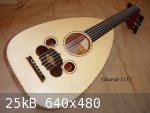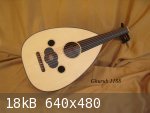Nazih Ghadban
Oud Junkie
    
Posts: 167
Registered: 5-25-2004
Location: Lebanon
Member Is Offline
Mood: No Mood
|
|
المنهج التجريبي في صناعة ا 
المنهج التجريبي في
صناعة الالات الوترية
أود القول ان الجانب
المادي المحسوس في صناعة
الالات الموسيقية مهم جدا
(القياس ونشر الخشب ولصقه
و حفه ودهانه ووو...), لكن
الموضوع الاكثر اهمية هو
في عقل الصانع وذهنه !
على الصانع ان يحاكي
الخشب ويجعله يستجيب لما
يدور في عقله وفي قلبه ,
يسمعه, يعرف قدرته في مدى
الاجابة والرنين وان
يكون العازف بداخلك
كصانع تشعر معه تتخيل هذا
العازف امام محبيه على
المسرح أثناء عزفه وآلتك
بين يديه
.
يقوم خبير الالات الوترية
الياباني وصانع
الغيتارات المشهور
والمعروف سايشي ساغويرا
Seiichi Sugiura
باختبار عودين من صناعتي
وذلك ضمن مشروع تعاون
بيننا لتحسين التوازن
الصوتي في آلة العود
ولاعطاء افضل صوت ممكن
وذلك من خلال دراسة
ومراقبة:
- صوت العودين
- شكل الصندوق
الصوتي(الطاسة لكل منهما لكل منهما
- الجسور :ارتفاعها
–سماكتها-مواقعها –نوعية
خشبها
- الفرس(مربط الاوتار نوع خشبه
واتجاه اليافه - شكله –
سماكته – ارتفاعه نوع خشبه
واتجاه اليافه - شكله –
سماكته – ارتفاعه
- القمريات : مواقع
القمريات على الصدر –
اتساع الفتحات والنسب
التي تحدد موقع القمريات
(نسبةFibonacci او النسب الصوتية ½
اوكتاف او 4/5 ...)
العودين هما :
- -عود "Ghurub 1112" : صدر انجلمن سبروس
طاسة من البادوك طول
الوتر 58.5 سنم
- عود "Ghurub 1188" صدر سبروس طاسة من
البادوك والجكرندا. طول
الوتر 58.5 سنم
وقد اعجبه العود 1112 لصفاء
ونقاء وغنى صوته وتوازن
الصوت في كل العلامات وهو
يقول ان الترددات
المنخفضة في العود تعود
وتتحدد في شكل الطاسة
وعمقها واتساعها بينما
الترددات
العالية(الحادة تعود لنوعية خشب الصدر
نفسه . وبعد ان طلب مني في
العود 1188 ان أزيد من ارتفاع
الجسور 20%عاد وشحذها كما في
العود 1112 وعمل على تخفيف وزن
الفرس (مربط الاوتار تعود لنوعية خشب الصدر
نفسه . وبعد ان طلب مني في
العود 1188 ان أزيد من ارتفاع
الجسور 20%عاد وشحذها كما في
العود 1112 وعمل على تخفيف وزن
الفرس (مربط الاوتار وصناعته من البادوك
وبذلك اصبح العود 1188 يشبه
بصوته العود 1112 . وصناعته من البادوك
وبذلك اصبح العود 1188 يشبه
بصوته العود 1112 .
اعتقد ان هذا المنهج
التجريبي في صناعة الالات
يؤكد لنا او يدحض بعض
النظريات في هذا المجال
ويساعدنا في الوصول الى
آلة عود مثالية .
https://www.youtube.com/watch?v=ZExStpAAhbI
https://www.facebook.com/nghadban1/posts/10210713421612079?notif_t=l...


|
|
|
Oud Freak
Oud Junkie
    
Posts: 291
Registered: 11-23-2007
Member Is Offline
Mood: Oud Jerk 
|
|
Very interesting article Mr. Ghadban, thank you for sharing.
Regards,
OF
|
|
|
suz_i_dil
Oud Junkie
    
Posts: 1061
Registered: 1-10-2008
Member Is Offline
Mood: No Mood
|
|
Hello Mr Ghadban, thank you for sharing this is very nice
I've been working on a few soundboard with a friend luthier here, and also been modifing some already make instruments.
I was amazed how we succeed to improve the sound of an instrument by lightening the bridge...and your video invite us to go even further. This is very
light how he worked on it.
I was also very interesting by the consideration of Seiichi Sugiura on the place of the little soundholes
The area around the bridge is indeed i think a main focus to have .
Then, in my personal experience, i'I been also very surprised how much a work on the main soundhole had repercussion on the sound and balance of the
instrument. A personnal input because he didn't talked of it in this video
I had an oud which didn't have good bass, which were too tight and unreasonnant. Have been well improved by shaping down the side braces of the
soundhole and the one ahead (under the fingerboard). At the opposite one which had a bad definition of the sound, an unsatisfying balance between bass
and trebles. Its voice was like " trying to talk with a hot potatoe in the mouth " has we say in french. This one was improved by a patch on the first
brace behind the soundhole (in direction of the small soundhole I mean).
Just a small contribution to bring my short experience in your field of art.
I was surprised by the repercussion in this area, particularly ahead the mains soundhole, under the fingerboard. Because most commonly people say it
is a " dead zone " ..which is definitely not I think
|
|
|
Alfaraby
Oud Junkie
    
Posts: 796
Registered: 9-18-2009
Location: Holy Land
Member Is Offline
Mood: Cool
|
|
First, Excuse me, but does anyone here understand Japanese ? I just couldn't read the white subtitles on the bright background.
Second, Shouldn't we know first how many ouds did this gentleman hear in his life in order to fix Mr Ghadban's oud sound ?
Third, is there a volunteer to translate the Arabic text to English ?
Yours indeed
Alfaraby
alfarabymusic@gmail.com
|
|
|
suz_i_dil
Oud Junkie
    
Posts: 1061
Registered: 1-10-2008
Member Is Offline
Mood: No Mood
|
|
Hello Jamil
I dont think the guy have the pretention to say how an oud should sound. He gives some tracks to open some frequencies, and how to control them.
If one decide that his oud sounding taste is toward weak basses, huge basses, undefined trebles or very tight, then you have some tracks. Those
tracks you can follow in its way or in the opposite way to have the result you wish. Like composing a perfume. There is not one sound for everybody to
agree on it, this you already know
The video is really informative and is enough by itself. I didn't have the time to learn Japanese last night, I felt lazy. ,fortunately my mobile
phone did the job for the subtitle to be readable. Did you tried on a bigger screen ?
Best regards
|
|
|
Alfaraby
Oud Junkie
    
Posts: 796
Registered: 9-18-2009
Location: Holy Land
Member Is Offline
Mood: Cool
|
|
Marouan my dear fellow !
My questions were not meant, in any way, to underestimate our Japanese friend. I just woundered how could Mr. Ghadban, for instance, like or dislike
the sound of a Biwa ?!
I tried to read the subtitles via cell & tablet, but haven't reache my PC yet.
Furthermore, hereinunder pls. find my contribution to this thread to show my interest and appreciation. Fair enough ?
See ? I'm not only a turbulent rowdy-dowdy 
OMG, I've just noticed that more than 7 yeras have elapsed since I first joined this exeptionally remarkable forum !
So thank you all for being tolerant this long 
Yours indeed
OLD
Alfaraby
alfarabymusic@gmail.com
|
|
|
Alfaraby
Oud Junkie
    
Posts: 796
Registered: 9-18-2009
Location: Holy Land
Member Is Offline
Mood: Cool
|
|
Experimental Method in String Instruments Making
Here's the English version :
Please add the English topic in the Arabic headline:
Though the physical tangible aspect in making musical instruments is very important (dimensions, sawing and gluing wood, sanding and dyeing etc.) I
believe that the most important aspect takes place in the luthier's brains and mind.
The maker should talk to the wood and make it respond to what is going on in his mind and in his heart. He should listen to the wood and get to know
its capability to resonate. During the making process, the maker should imagine the player with the luthier's instrument in his hands, playing on
stage, in front of his fans.
The famous string instruments Japanese expert and guitar maker Seiichi Sugiura tested two of my ouds, as part of a cooperation project between us to
improve the acoustic balance of the oud and give it the best possible sound. He studied and watched two of my ouds, their sounds, their bowl shapes,
their braces and bridges (height, location, timber, direction), their soundholes location and dimensions, Fibonacci sequence.
The two ouds he checked were:
Ghurub 1112: Paddock bowl, engelmann spruce soundboard, 585 mm scale
Ghurub 1188: Paddok & Jacaranda bowl, spruce soundboard, 585 mm scale
Mr. Sugiura liked 1112 oud for its pure rich sound & balance. He stated that the low frequencies are produced due to the volume and wood/s of the
bowl, while the higher frequencies are subject to the soundboard.
He asked me to make 20% higher braces in 1188 oud and shape them just like I did in 1112 oud, and by reducing the Paddok bridge weight, it sounded
like the 1112 oud .
I believe that this experimental method in making instruments emphasizes or contradicts some theories in this field and helps us to reach the ideal
oud.
https://www.youtube.com/watch?v=ZExStpAAhbI
https://www.facebook.com/nghadban1/posts/10210713421612079?notif_t=l...
Thank you
Yours indeed
Alfaraby
alfarabymusic@gmail.com
|
|
|
majnuunNavid
Oud Junkie
    
Posts: 622
Registered: 7-22-2013
Member Is Offline
Mood: Dude, where's my Oud?
|
|
I'm completely biased, but everything that Japanese seem to touch they have the uncanny ability to improve upon! I look forward to check out this
video.
|
|
|
suz_i_dil
Oud Junkie
    
Posts: 1061
Registered: 1-10-2008
Member Is Offline
Mood: No Mood
|
|
Ha ha, Jamil
always a pleasure to read you turbulent fellow !
Thank you for the translation. I think this kind of work always valuable ... maybe once we can get out from the idea " good old days when our
ancestor knew to build ouds" .. How sad all this has been lost...and just focus on the build and share experiments and tracks to improve the global
level of building.
sincerely
|
|
|
IlPersiano
Oud Maniac
   
Posts: 62
Registered: 1-8-2016
Member Is Offline
|
|
ahahaha! guys! I love you Marouan and Jameel! 
Thank you both to bring this interesting article to light also for non arabic readers.
|
|
|
Oud Freak
Oud Junkie
    
Posts: 291
Registered: 11-23-2007
Member Is Offline
Mood: Oud Jerk 
|
|
Quote: Originally posted by Alfaraby  | First, Excuse me, but does anyone here understand Japanese ? I just couldn't read the white subtitles on the bright background.
Second, Shouldn't we know first how many ouds did this gentleman hear in his life in order to fix Mr Ghadban's oud sound ?
Third, is there a volunteer to translate the Arabic text to English ?
Yours indeed
Alfaraby
|
Subtitles: you're right.
In all cases there is a pause button which can be used, if one is really interested in the topic 
How many oud did this gentleman hear: he's a luthier and a luthier has supposedly an advanced perception about instruments. In addition there is
internet nowadays, he might know more than all of us do (maybe?).
|
|
|
majnuunNavid
Oud Junkie
    
Posts: 622
Registered: 7-22-2013
Member Is Offline
Mood: Dude, where's my Oud?
|
|
Quote: Originally posted by Oud Freak  |
How many oud did this gentleman hear: he's a luthier and a luthier has supposedly an advanced perception about instruments. In addition there is
internet nowadays, he might know more than all of us do (maybe?).
|
I don't think any alterations he's making would affect it so much that it sounds less oud-like. My understanding from the video is that he likes the
sound of the oud on the table and he's trying to recreate the same effectiveness of sound production in the Oud on the table. I think he's going for
overall sound quality and bringing out certain frequencies that are hidden in that Oud.
Where are some sound files to listen to? I want to hear the result!
|
|
|